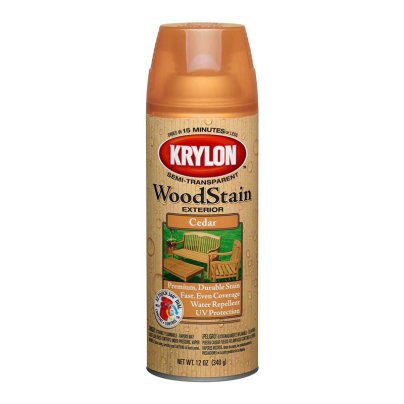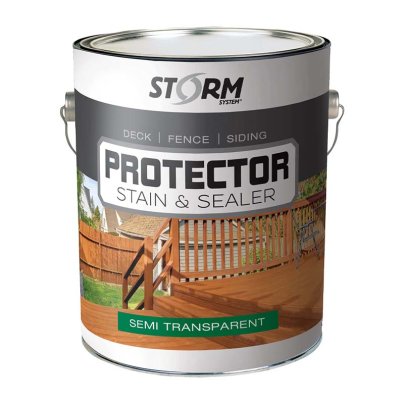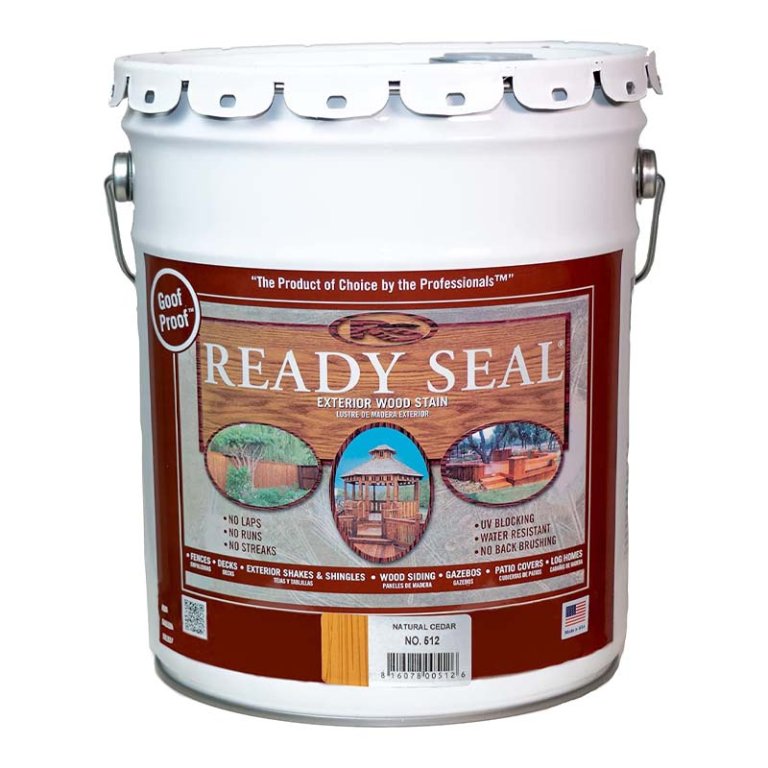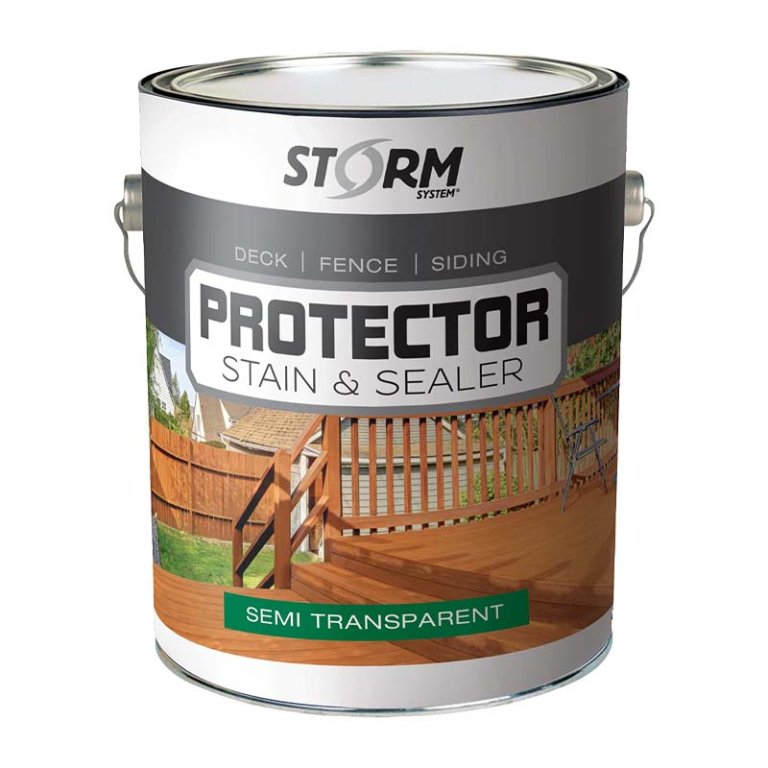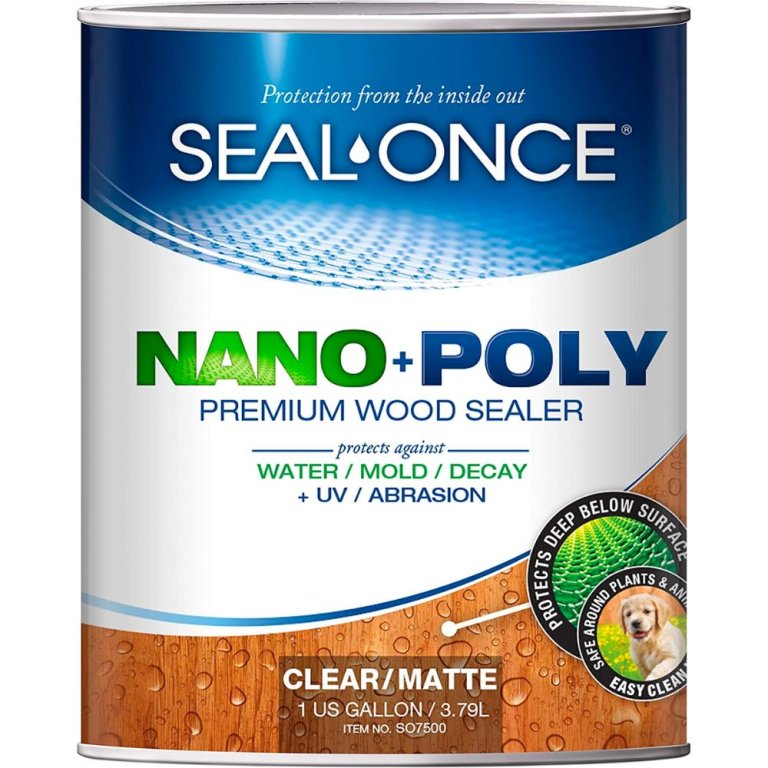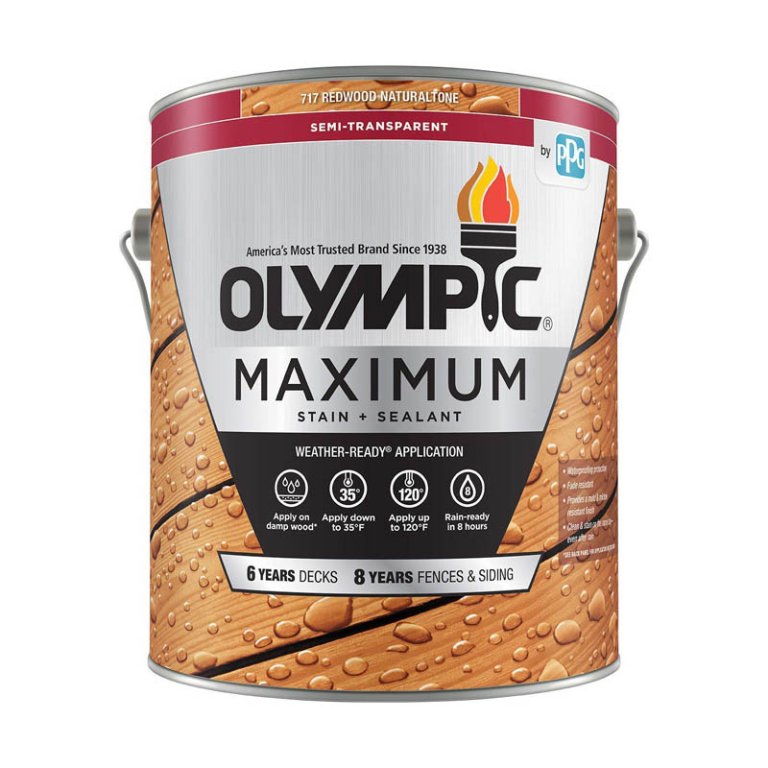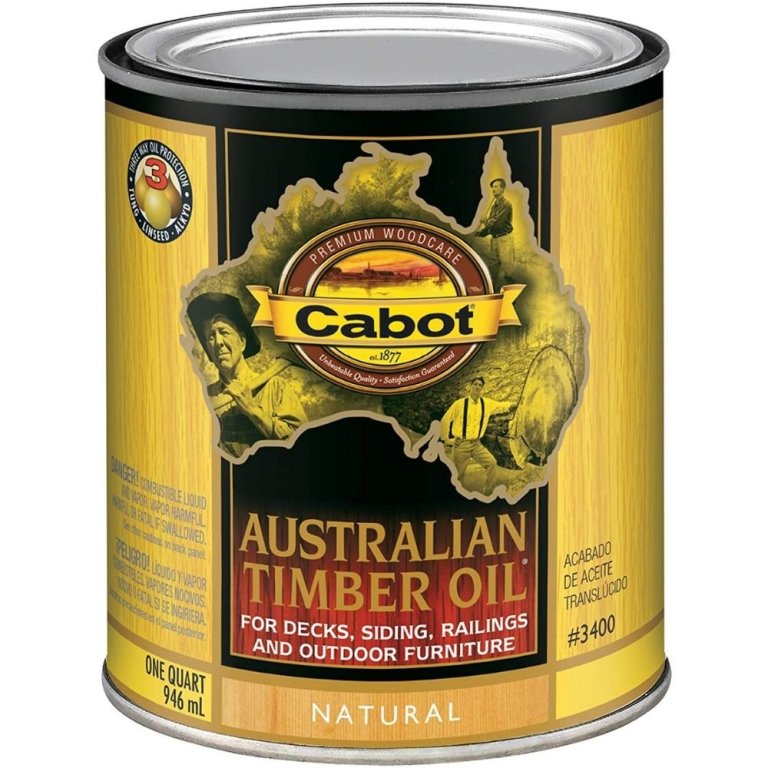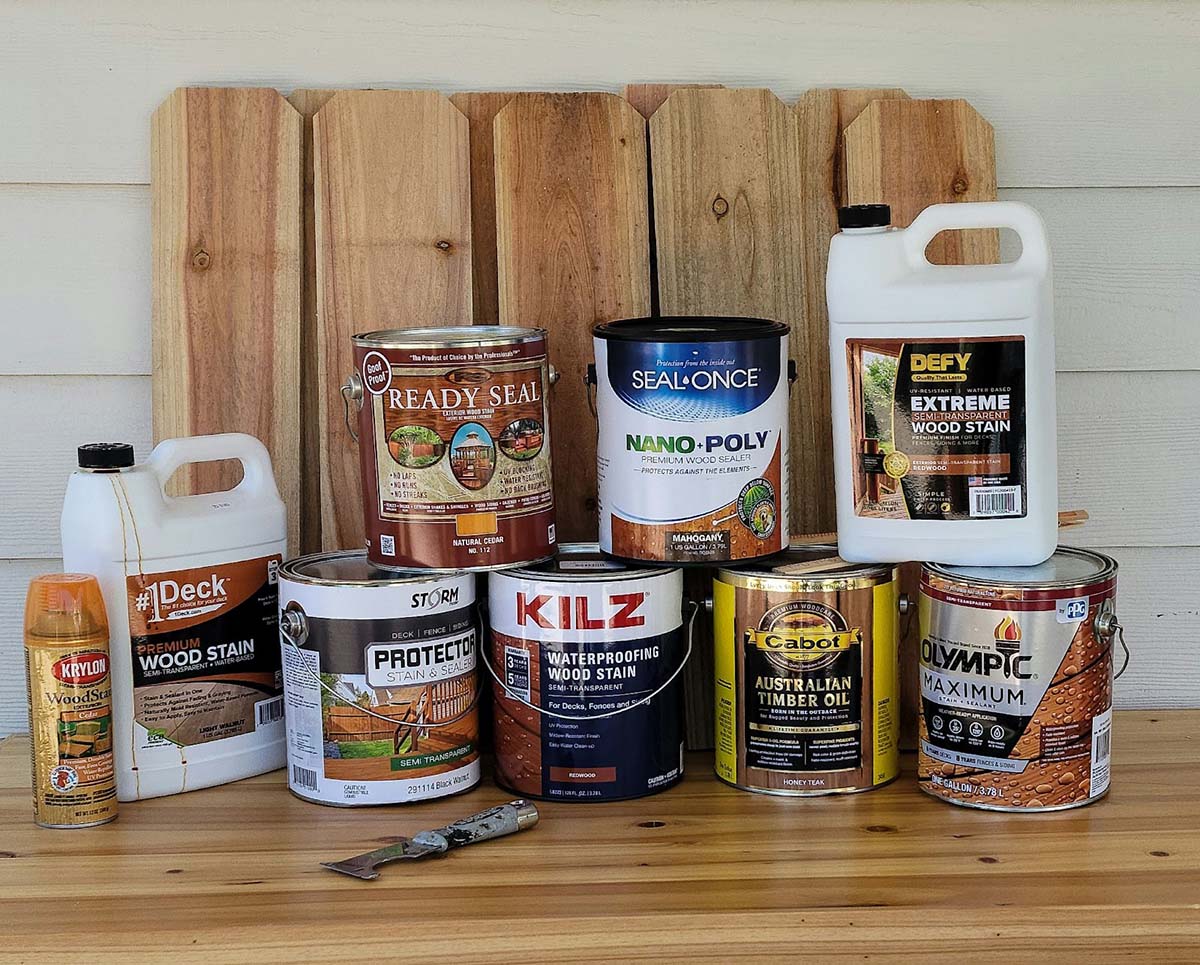
We may earn revenue from the products available on this page and participate in affiliate programs. Learn More ›
Whether adding privacy to a yard, accenting the garden, or keeping pets contained, fences can be the finishing touch to tie a property together. But a beautiful wood fence will be susceptible to damage from the elements: the sun’s ultraviolet (UV) rays and the onslaught of moisture from rain, snow, and humidity. This can cause drying, cracking, warping, and weathering of a wood fence.
Staining a fence can help protect it from damage, but it’s typically a time-consuming and expensive project. We wanted to find out which fence stains were truly worth the effort and investment. After all, the more upfront research you do, the more apt you are to be pleased with the results. We spoke to Tanner Hamby, operations director for Stand Strong Fencing, based in Omaha, Nebraska, to get his professional opinion. We also put the top fence stain products on the market through their paces to determine how easy (or challenging) they were to apply; whether they imparted a rich, uniform tone; and whether they would stand up to the elements or fade after a few sunny days.
We applied the different stains to new fence boards, and then we subjected the boards to situations that mimicked blowing rain, dust storms, and harsh sunrays. We tested them intensely for 4 weeks and then examined how well each stain product fared. Ahead, learn what to look for when shopping for a fence stain, and find out how the following products earned a spot on our list of the best fence stains.
- BEST OVERALL: Ready Seal Exterior Wood Stain and Sealer
- BEST BANG FOR THE BUCK: Krylon Exterior Semi-Transparent Wood Stain
- BEST FOR NEW WOOD: Storm System Protector Stain and Sealer
- BEST FOR OLD WOOD: Seal-Once Nano+Poly Premium Wood Sealer
- BEST WITH SEALER: Olympic Maximum Wood Stain and Sealant
- BEST STAIN ONLY: Cabot Australian Timber Oil Wood Stain and Protector
- BEST WATER-BASED: SaverSystems #1 Deck Premium Wood Stain
- ALSO CONSIDER: Defy Extreme Semi-Transparent Wood Stain
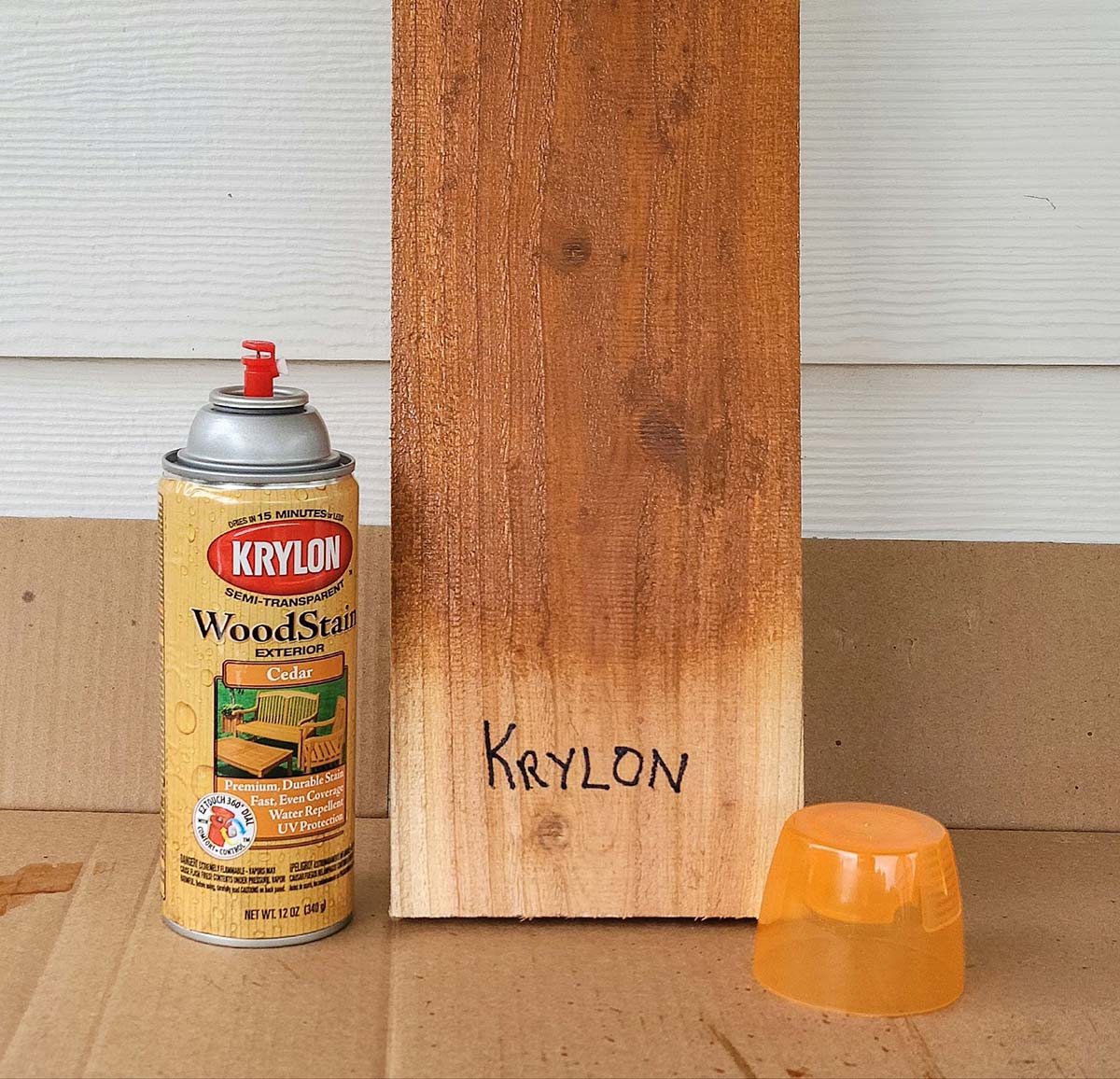
How We Tested the Best Fence Stains
Hamby recommends the following when looking for fence stain: “Wood type is crucial for choosing the right stain. Some woods, like cedar or redwood, naturally resist decay so they can last longer with less protective coverage.” He adds that others, such as pine or spruce, are more susceptible to rot and decay and benefit well from a protective stain.
We made sure to select a wide range of options to cover several wood types and user preferences. We researched the most sought-after fence stains in their respective categories to select a variety of options that included both oil-based and water-based products, as well as those that contained sealant and those that didn’t.
During the testing phase, we stained test fence boards with each product and noted how uniformly the stain penetrated the wood. We applied the recommended number of coats according to the product’s directions and let each board dry thoroughly before submitting it to the sun’s rays, water, dirt, and power-washing for 4 weeks. We awarded points based on a rubric for each of the tests.
After the testing, we cleaned the boards and examined them for signs of faded color, dullness, or peeling. At the end of the testing, we added the points for each stain product and used them to categorize the products.
| Testing Stats | |
| Products tested | 8 |
| Hours spent testing | 20+ |
| Tests performed | 2 to 3 |
| Price range | $30 to $180 |
Our Top Picks
To qualify for a spot on our lineup of the best fence stains, the products we tested had to be straightforward to apply—either brush or spray on. They had to impart a rich, uniform tone and withstand our simulated tests mimicking harsh outdoor elements. We inspected the stained fence boards throughout the testing phase and noted how well the stain held up. The following products represent the best of the fence stains we tested, and one is sure to be the right pick for your fence-staining project.
BEST OVERALL
Ready Seal Exterior Wood Stain and Sealer
What We Like
- Does not leave behind any streaks, runs, or laps; does not require any back brushing
- Natural-looking cedar wood tone (offered in multiple finishes to suit multiple users’ preferences)
- Original wood grain is maintained and enhanced for a natural look after application
- Contains sealer as well as a stain to protect against mold and mildew
What We Don’t Like
- Long drying time (72 hours) compared to other options available
- Mineral spirits are required for cleaning brushes after application
Product Specs
- Stain base: Oil
- Opacity: Semitransparent
- Application method: Spray, roll on, brush on
This Bob Vila Approved product carries our brand’s highest level of recommendation.

Bob Vila Approved recognizes the household and DIY products that impressed us most in our real-world testing and that exemplify core values of the Bob Vila brand, including craftsmanship, innovation, and value for the dollar. Winners of this designation come recommended by our professional review team and are personally approved by Bob Vila.
Our Ratings: Color 5/5; Ease of Application 5/5; Drying Time 3/5; Value 5/5
Ready Seal exterior wood stain and sealer can be applied using a paint sprayer, a brush, or a roller. (In tests, we went with a brush, as we feel it’s the best way to get uniform coverage.) The manufacturer bills Ready Seal as streak-free and run-free, but like all liquids, we discovered it will run if brushed on heavily. We did not notice any streaks, however.
We applied the stain in a natural cedar tone and really liked the rich color. We applied two coats (as recommended) 45 minutes apart, and then let the board dry for 72 hours.
After it dried, we took it outdoors with the rest of the test boards and nailed it to a wooden frame at a 45-degree angle where it received near-direct sunrays. We sprayed it with water, dumped dusty dirt on the wet surface, and let the dirt dry. After a week, we resprayed the board with a pressure washer. We repeated the wetting/dirtying process twice more during the testing period, and each time we used a pressure washer to clean the boards.
After the 4-week test period, we power-washed the boards one last time and then let them dry completely before examining them. The board with Ready Seal looked nearly as good as when we first applied the stain. It had a few spots where wood was missing—but that was the fault of the high-pressure water, not a stain failure. The color still looked fresh and vibrant, making this our top pick for a fence stain.
Get the Ready Seal fence stain at Amazon, Lowe’s, or The Home Depot.
BEST BANG FOR THE BUCK
Krylon Exterior Semi-Transparent Wood Stain
What We Like
- Convenient and easy-to-use spray; suitable for touch-ups and trouble spots
- The color goes on uniformly and has a natural hue; comes in 5 finish options
- Dries in just 15 minutes and protects against UV rays and moisture
What We Don’t Like
- Faded slightly after testing; may not be a long-term stain option
Product Specs
- Stain base: Oil
- Opacity: Semitransparent
- Application method: Spray
Our Ratings: Color 3/5; Ease of Application 5/5; Drying Time 5/5; Value 4/5
This inexpensive 12-ounce can of fence stain is an excellent option for touching up worn or faded portions of a stained fence without investing in an entire bucket of fence stain. We also found it suitable for staining small fence projects, such as a short perimeter fence around a rock garden or flower bed.
Having prior experience with aerosol-type spray paints, our initial concern was that it would be challenging to spray the Krylon stain on the wood without noticeable runs. We were pleasantly surprised at how uniform the color went on and penetrated the wood. We still had to take care not to hold the can too close to the wood—the instructions recommend a distance of 8 inches—and we had to keep the can in motion, swiping back and forth to prevent leaving a too-heavy concentration in any one spot. Overall, the stain came out evenly and went on smoothly with no splutters or drips.
We chose to test this semitransparent stain in cedar tone, and Krylon imparted a lovely, natural hue, but the resulting effect looked slightly dry, as if it had already aged a few months. Though we chose this option to test, the stain comes in four other finish options. On the upside, the board dried to the touch in less than 5 minutes. However, the manufacturer states that it takes a full 15 minutes to be completely dry to the touch.
We tested the board outside with the other boards—angling it toward the sun, wetting it, covering it with dirt, and pressure washing it three times. At the end of the testing phase, the Krylon-stained board still retained its color but had faded slightly. It didn’t have quite the staying power as some of the other stains, but the tone was still apparent and attractive. We feel this affordable fence-staining spray is better suited to a fence that isn’t in direct sunlight all day to keep the color looking good as long as possible.
Get the Krylon fence stain at Amazon, Ace Hardware, or Valu Home Centers.
BEST FOR NEW WOOD
Storm System Protector Stain and Sealer
What We Like
- Goes on uniformly and penetrates the wood effectively; works as a stain and sealer
- Color lasts for long-term reliability; comes in multiple finishes to suit various users’ preferences
- Repels moisture and dirt effectively; ideal for long-term reliability and new fences
What We Don’t Like
- Mineral spirits needed to clean up brushes after application
Product Specs
- Stain base: Oil
- Opacity: Semitransparent
- Application method: Brush, roll, or spray
Our Ratings: Color 5/5; Ease of Application 3/5; Drying Time 5/5; Value 4/5
While the Storm System Protector stain and sealer can be used on any wood fence, it’s especially well suited to new fences as it imparts both color and a protective seal to enhance the longevity of the wood.
We chose to test Storm System Protector in a semitransparent black walnut tone, and we really liked the depth and richness of the color. We brushed on a single coat, waited 24 hours as recommended, and then brushed on a second coat. The stain went on uniformly and penetrated the wood quickly. The second coat deepened the shade, bringing out the wood grain even more. After another 24 hours, we were able to start testing.
One of the interesting things about this stain is that after wetting down the board and sprinkling dry dirt on the surface, most of the dirt fell off when the board dried. On the other test boards, the dirt adhered to a greater extent. The same thing happened each time we repeated the test, leading us to believe the sealer in the Storm System was keeping the dirt from sticking.
After the testing phase, we examined the board closely. The color was just as deep and rich as when applied, and the wood looked fresh and new. We feel this stain would be a good investment in protecting a new fence from the get-go, and it may keep the wood looking cleaner by repelling stuck-on dust.
Get the Storm System fence stain at Amazon or Pro Solutions Direct.
BEST FOR OLD WOOD
Seal-Once Nano+Poly Premium Wood Sealer
What We Like
- Penetrates uniformly for lasting color; the manufacturer recommends this option for high-traffic areas
- Made nontoxic with low VOCs and UV blockers for long-term protection against fading
- The highly absorbent formula is suitable for new or old wood varieties
- Easy cleanup with just soap and water after application
What We Don’t Like
- May raise wood grain and create a rough texture on the fence
- Pricey compared to other stains on the market
Product Specs
- Stain base: Water
- Opacity: Semitransparent
- Application method: Brush or spray
Our Ratings: Color 5/5; Ease of Application 4/5; Drying Time 4/5; Value 4/5
Building a new wood fence is a pricey prospect, so for most homeowners, keeping an older one looking good as long as possible is the goal. Seal-Once Nano+Poly is a viable option for staining and sealing weathered wood fences. Old wood tends to feature various grain densities because some of the grain may have swollen over time, while other parts may still be as dense as when the wood was new. This can lead to blotchy results when using an oil-based stain. We selected what appeared to be the oldest fence board in our test pile to try out Seal-Once.
We chose a semitransparent mahogany tone for this stain, but other colors are available. The stain brushed on evenly and penetrated quickly. We applied a second coat 20 minutes after the first, which is recommended as the second coat must be applied while the first is still damp. In 4 hours, the board was dry, and in 48 hours, it was ready for testing.
During the next 4 weeks, the board was repeatedly subjected to UV rays, water, dirt, and power-washing. After the final power-washing, we examined the board. The color was just as dark and rich as when we first applied it, even though dark colors are typically most likely to fade. One slight downside was that Seal-Once seemed to raise the wood grain—the board felt rougher to the touch. However, this is pretty common for a water-based product and even more common with old wood, which has a more porous grain to begin with. Another nice aspect: We were able to wash our paint brush with just plain soap and water when we were done.
Get the Seal-Once fence stain at Amazon, The Home Depot, or Seal-Once.
BEST WITH SEALER
Olympic Maximum Wood Stain and Sealant
What We Like
- Provides a natural-looking wood tone; comes in 4 finishes for excellent versatility
- Should provide long-lasting vibrant color; sealant included in the formula
- Offers excellent versatility; can be applied on damp wood or 8 hours before a rainfall
- Cleans up with soap and water after application
What We Don’t Like
- Slight sheen after application (fades in time)
Product Specs
- Stain base: Water
- Opacity: Semitransparent
- Application method: Spray or brush
Our Ratings: Color 3/5; Ease of Application 4/5; Drying Time 4/5; Value 4/5
This Olympic stain combines the advanced UV protection of a stain with the enhanced waterproofing of a sealant. The stain and sealer combo will help protect fences and keep them looking great. The can arrived banged up and dented, but fortunately, the stain hadn’t spilled, and the bumps and bruises didn’t seem to affect its quality.
This water-based stain comes in various colors and opacities. We tested a redwood tone in a semitransparent opacity. We applied a single coat (as recommended) with a brush to our test fence board, and it penetrated quickly and uniformly. The color seemed true—some redwood shades look strangely orange—but this was a natural-looking tone. We also detected a very slight sheen when turning the board at an angle, which we assumed was due to the included sealant, although the manufacturer does not say the product has a sheen.
After waiting 48 hours, the board was ready for testing. It withstood repeated water, dirt, UV rays, and power-washing over the next 4 weeks, and upon final examination, the color seemed just as vibrant as before. The sheen we noticed before was gone, however, and the wood grain looked natural.
Get the Olympic fence stain at Amazon or Tractor Supply Co..
BEST STAIN ONLY
Cabot Australian Timber Oil Wood Stain and Protector
What We Like
- Penetrates uniformly to enhance the grain of the wood while protecting
- Rich, attractive tone comes in multiple finish options including honey teak, mahogany flame, and amberwood
- Long-lasting color formula; made with natural moisture-repelling ingredients to prevent fading
What We Don’t Like
- May be hard to clean up; requires mineral spirits after application
Product Specs
- Stain base: Oil
- Opacity: Semitransparent
- Application method: Brush or spray
Our Ratings: Color 5/5; Ease of Application 3/5; Drying Time 3/5; Value 4/5
Cabot Australian Timber Oil uses the natural moisture-repelling features of linseed oil, tung oil, and long oil alkyds to increase the fence’s life while enhancing its wood grain. So while Cabot Australian Timber Oil doesn’t technically include a separate chemical sealant ingredient, it contains oils that double as natural sealants.
We tested Australian Timber Oil in a warm honey teak tone and liked the look. We brushed on a single coat (as recommended), which penetrated the wood evenly and imparted a natural-looking tone. After 72 hours, the board was ready for testing.
Australian Timber Oil contains Trans-Oxide pigments that purportedly offer better UV protection than stains with synthetic pigments. We can’t be sure if that was what protected the color on the test board, but after the 4-week test period, the board with Australian Timber Oil looked as good as when we first applied the stain. The color was just as deep and rich as before, making this stain-only product among our personal favorites.
Get the Cabot fence stain at Amazon or Ace Hardware.
BEST WATER-BASED
SaverSystems #1 Deck Premium Wood Stain
What We Like
- Can be applied to damp wood for excellent application versatility
- Formula is a stain and a sealant in one; protects against moisture and UV rays
- Cleans up with soap and water after application; no mineral spirits required
- Long-lasting color dries in a flat and natural finish
What We Don’t Like
- Excess dirt stuck to the test board, unlike other stains on the market
Product Specs
- Stain base: Water
- Opacity: Semitransparent
- Application method: Brush or spray
Our Ratings: Color 4/5; Ease of Application 5/5; Drying Time 5/5; Value 4.5/5
The water-based stain and sealant from SaverSystems allows the wood grain to show through, is easy to clean up, and works well with soft and hardwoods. It’s billed as a wood deck stain but is also optimal for wood fences.
We tested a semitransparent light walnut color, but we varied the way we applied this stain. The label states that it can be applied to damp wood, so to test that claim, we wet the test board by spraying it with the garden hose and then let it dry until it was just damp. Then we applied a single coat of the wood stain. It went on well, but we had to wait until the board dried before we could see if it had penetrated uniformly. It had, so after determining that, the board went outdoors for testing.
During the testing process, we noticed that the dirt we tossed on the wet board adhered thickly. We weren’t sure why, but after we completed the testing, the color of the stain was still vibrant. We were a little concerned about the board retaining so much dirt, however, and this might be a consideration for someone who lives in an area that sees frequent dust storms.
Get the SaverSystems fence stain at Amazon.
ALSO CONSIDER
Defy Extreme Semi-Transparent Wood Stain
What We Like
- 2 coats penetrate the wood uniformly for long-lasting coverage; comes in a variety of color options
- Cleans up with soap and water after application for added user-friendliness
- Resists UV rays, water, and dirt effectively for reliable use
What We Don’t Like
- Slightly pricey compared to other tested stains
- Color tone seemed slightly off; may not be ideal for some users’ preferences
Product Specs
- Stain base: Water
- Opacity: Semitransparent
- Application method: Brush or spray
Our Ratings: Color 3/5; Ease of Application 4/5; Drying Time 4/5; Value 4/5
We found the Defy Extreme semitransparent wood stain to be another quality fence stain product. It’s a water-based formulation that went on uniformly and quickly penetrated the test board. We brushed on two coats as recommended and applied the second coat before the first coat was completely dry. That deepened the color but not substantially. The label says a third coat can be used, but we went with just two.
We tested this stain in a semitransparent redwood tone and found it a bit too red for our taste. The test board came through the 4-week testing period with flying colors, and the final tone was just as rich and red as when we’d freshly applied it. The color didn’t seem affected at all by the harsh sunrays, power-washing, or dirt tests. We felt it was one of the more durable and lasting stains, but we weren’t fans of the tone itself. Cleanup was simple, however, with just soap and water.
Get the Defy fence stain at Amazon.
Jump to Our Top Picks
What to Consider When Choosing a Fence Stain
Wood stains contain pigments and ingredients that help deflect harmful UV rays. Some contain sealant blends and natural oils that help protect against moisture damage. Whether a wood fence is new or old, a coat of high-quality stain can accent the natural wood surface, protect the wood from weathering, and add curb appeal to a home. Some key considerations for long-lasting protection include opacity and whether the stain comes with a combined sealant to help lock out moisture and protect the fence from mold, mildew, and rot. Read on to learn more.
Wood Type
Most wood fences can be painted or stained, but the kind of wood surface can determine the number of coats, type of stain, color of stain, time spent on prep work, and amount of stain required.
Some woods have beautiful grain patterns that can be accentuated with a light-tone stain rather than obscured with a dark stain. The following are a few popular wood species used for fences and some characteristics that can affect the finished look.
- Walnut, cherry, and mahogany can be challenging to stain. The pores between their wood fibers are too small to absorb stain without significant preparation and sanding beforehand, so staining may not be as good an option as painting. Alternatively, applying an oil-based sealant can be a workable solution.
- Softwood fences like pine and cedar absorb stain quickly and easily, but a water-based stain can cause problems with these woods. Softwoods have larger pores that absorb stain more readily than hardwood. However, some softwoods, such as cedar, contain oils that can keep water-based stains from absorbing evenly. Avoid this issue by using an oil-based stain, which is the best stain for cedar fences.
- Hardwoods like oak and ash can easily absorb most types of stain. These woods have relatively large pores to absorb stain well, so there are many choices available when it comes to the color, type, and opacity of a stain.
- Pressure-treated wood fences have had chemicals applied to make them more durable, but this can prevent stain from absorbing evenly, leading to a blotchy appearance. The general rule is to wait 6 months after having a new treated-wood fence built before staining or painting to give the chemical in the wood a chance to evaporate.
Opacity
The opacity of a stain refers to how much of the wood grain will be visible after the stain is applied. In general, the more opaque a stain is, the more it will cover the grain, so to maintain the grain look, opt for a transparent stain. A dark color in a solid stain is the best way to cover the grain fully.
- Solid stains create a film on top of the wood that completely masks the grain. These stains look more like paint and give the best UV protection, but they are the most vulnerable to chipping.
- Semi-solid stains will hide almost all of the wood grain and natural color while providing a high degree of UV protection.
- Semitransparent stains go on much lighter and allow more of the wood grain detail and color to come through. However, with higher transparency, the UV protection of the wood stain decreases.
- Transparent stains are clear and do not provide much UV protection. These stains typically contain sealant and are better for water protection.
Base
Choosing between a water-based and oil-based stain is often a matter of preference. The question isn’t which is better than the other, but rather what type of wood they’re applied to, how quickly they dry, and how often the user is willing to restain the fence.
- Water-based stains don’t always work well for softwoods because some, such as cedar and pine, contain natural oils that can leave a blotchy look. However, on hardwoods, they offer a quick-drying solution (in as little as 1 to 3 hours), and application tools (brushes or rollers) clean up quickly with just soapy water. On the downside, water raises the grain of the wood, which can give a rough finish.
- Oil-based stains can be used on most softwoods and hardwoods, but they take longer to dry than water-based stains (up to 72 hours for some products).Oil-based paints and stains also tend to be more durable, lasting longer than water-based formulas.
Sealant
Sealant provides an extra level of wood protection. Stain formulas that lack sealant can leave fences susceptible to moisture damage, and some colors will fade over time. Stain/sealer combos can last up to 3 to 5 years before requiring reapplication, based on the product chosen and the condition of the wood. Old wood tends to be drier and more absorbent and requires more frequent staining to retain its good looks than newer wood.
Separate sealers can be applied on top of a stained wood fence to stave off UV damage and provide adequate protection from the elements. While guidelines change with the manufacturer and the climate, a general rule is to stain wood fences every 5 years and then apply a penetrating sealant on the off years in between to provide long-lasting protection.
Additional Features
The average stain brand offers four to eight different wood-look color choices, although some tones are more popular than others, such as redwood, cedar, and walnut. Some manufacturers offer nontraditional stain colors, such as green or gold, but most users seem happiest with tones that look more like natural wood.
Those interested in environmentally responsible products and limiting exposure to harmful chemicals should consider an eco-friendly stain. Rather than rely on harsh compounds to seal the wood, these products use natural alternatives, such as tung oil or linseed oil, which are less damaging to the environment and don’t have a powerful chemical smell that can induce headaches or nausea in some people.
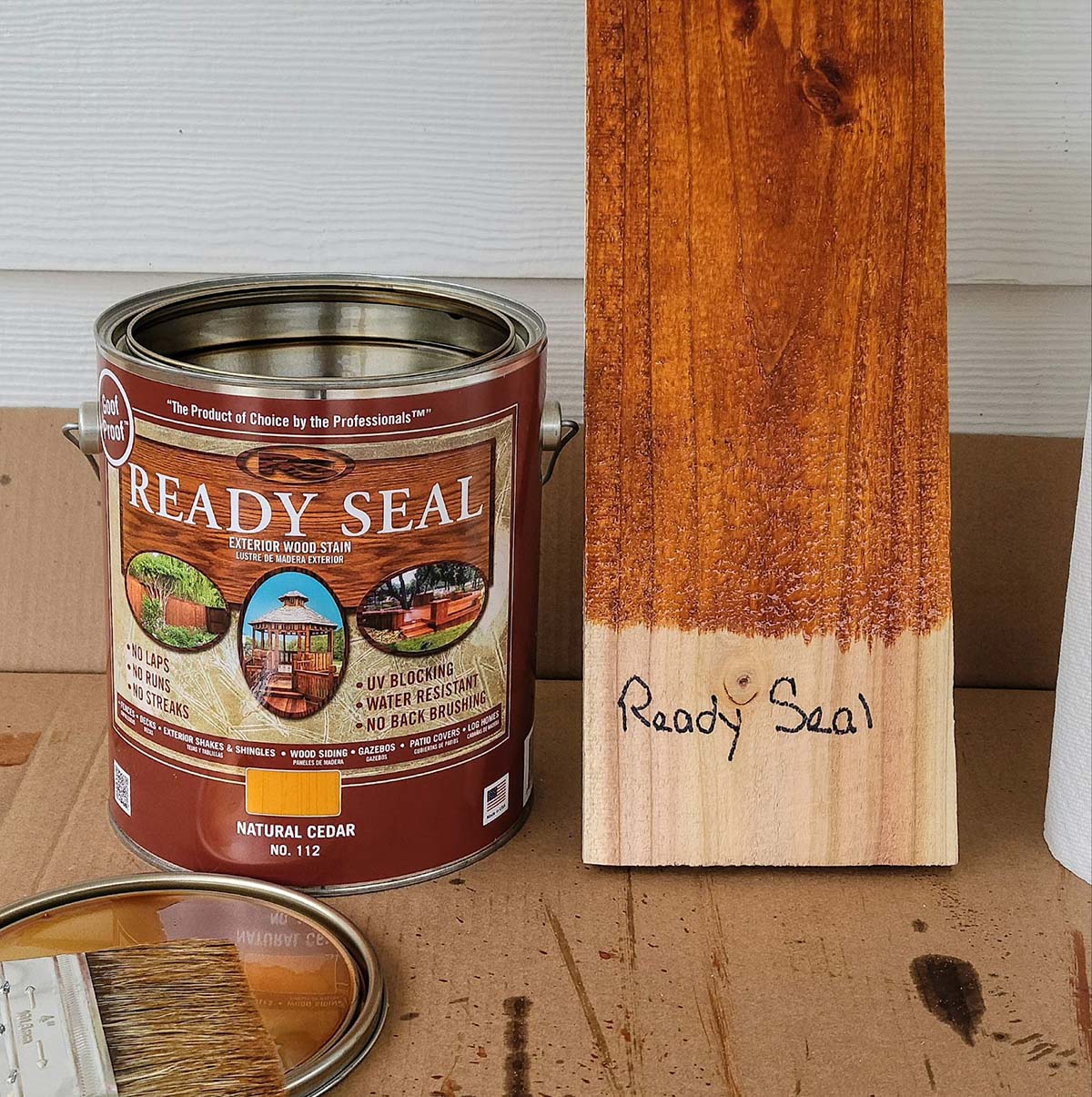
How to Prep a Fence for Staining
Before picking up the paint brush, a fence must be properly prepared for best results. Preparing a fence for staining involves inspecting, repairing damage, sanding, and washing the fence boards.
- Inspect the fence wood for chips, cracks, or rotting boards that need to be replaced.
- Sand the fence boards to remove any previous paint or stain. If the fence boards are not sanded, the stain may not be evenly absorbed, resulting in a splotchy appearance.
- Finally, grab the hose and a power washer to remove any remaining dirt and debris so that the stain can be readily absorbed into the wood, producing an even, attractive barrier that looks great and keeps the fence safe for years to come.
Tips for How to Stain a Fence
After the fence has been inspected, repaired, sanded, and washed, it’s finally time to stain the fence. Check the weather and choose a calm, dry day with temps between 50 and 85 degrees Fahrenheit.
- Use painter’s tape and drop cloths to protect areas you don’t want to stain, like lawn ornaments, rose bushes, and paving tiles.
- When the area is ready, grab a brush, roller, or paint sprayer (check instructions on the can for suitable application methods) and apply the stain evenly to the fence.
- When using a paint brush, apply in the direction of the wood grain for the best results.
- Apply a second coat if recommended by the manufacturer. Some products are designed for just one-coat application; once that first coat dries, it forms a seal that will keep a second coat from penetrating the wood.
- If the stain doesn’t include sealant, consider applying a top coat of sealer to protect the wood.
FAQs
Staining a fence helps protect it from the elements. If you still want more information about the best fence stain, including whether paint is a better option or how long the color lasts, read on for answers to some of the most commonly asked questions about staining a fence.
Fences are regularly exposed to rain, sleet, snow, wind, and direct sunlight that can cause paint to peel, crack, and blister. While exterior paints are designed to withstand these elements, in most cases, a stain is a better option for a fence because it penetrates the wood rather than coating its surface.
The stain color depends on your personal preference, but some popular options include gray stains for a modern look or natural green colors to help the fence blend in with landscaping in the yard. Natural wood tones, such as redwood and cedar, are always popular.
Oil-based stains that have a solid opacity last the longest. If properly cared for, these stains can last up to 5 years before the fence needs to be stained again.
To stain a wood fence properly, you’ll need a paint brush, drop cloths to protect the grass and nearby items, and protective clothing that you can throw away when you’re done because they’ll likely be permanently stained.
Meet the Tester
Glenda Taylor is a product tester and writer specializing in the construction, remodeling, and real estate industries. She and her husband own a general contracting company, and Taylor is experienced in both residential and commercial building applications. She tests a wide range of power tools as well as other home improvement, household, and lawn-and-garden products.

